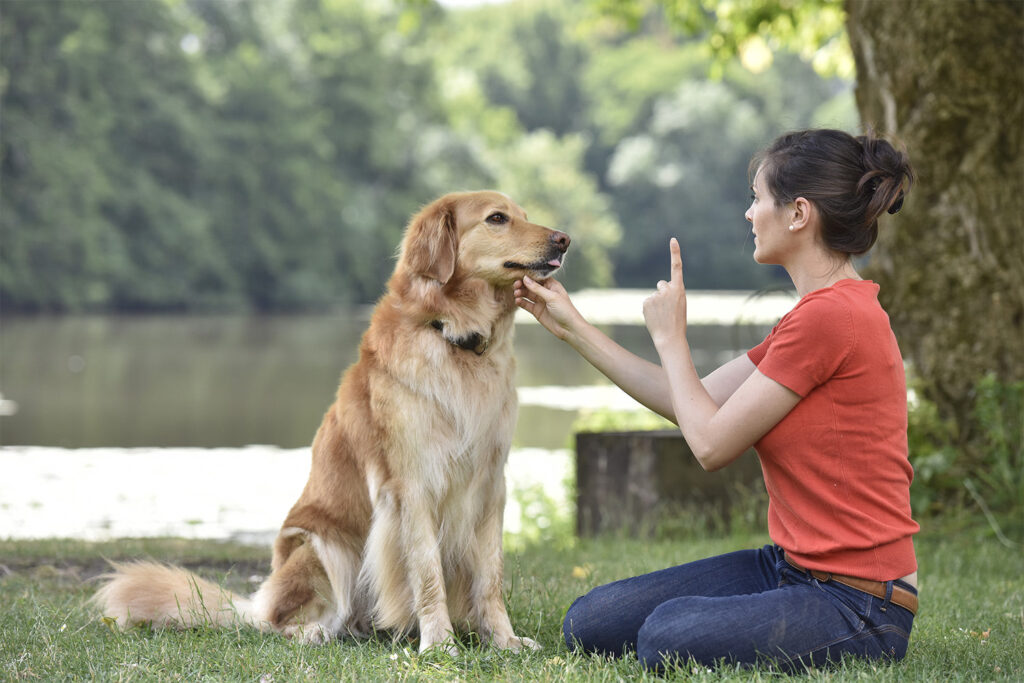
.
Most dog owners use verbal commands to instruct their dogs to sit or stay. This often works well, but some dogs may not get the message so clearly. In many cases, dog training hand signals can resolve a communication gap between you and your dog.
Try teaching your dog a few training hand signals. Hand signal training can be a productive and rewarding way to bond with your dog while providing mental stimulation and enriching your dog’s life.
There are several great reasons to use dog training hand signals. Dogs that are hard of hearing or fully hearing-impaired won’t be able to understand verbal commands. In these cases, hand signals are absolutely necessary. There is no other way to give these dogs commands.
Sometimes, dogs who can hear cannot understand. Your dog may have a general idea of what you’re saying, but you and your pup will always speak different languages. Dogs understand and interpret in a way that makes sense to them, and some dogs aren’t strong auditory learners. Dogs can clearly see hand signals and will interpret them differently from spoken language.
If you’ve already trained your dog with verbal commands, you can train your dog with hand signals as well. This is great mental stimulation for your dog, giving them a new goal to work towards and encouraging them to explore the world and their environment in a different way.
An effective training session with your dog requires a conducive environment and a concise approach. Hand signals aren’t something you can practice in the middle of a busy day. You’ll need to set aside some time to work with your dog, and remaining consistent is key to helping your dog memorize new information.
Hand signal training should take place in a room with just you and your dog. Outside noises or distracting visuals can easily draw away your dog’s attention, causing them to miss the message.
Your dog might think you look strange at first, naturally misunderstanding the point of what you’re doing with your hands. Blocking out competing points of interest will encourage your dog to pay more attention to what you’re doing with your hands.
It may help to direct your dog’s attention. You can use a training clicker to get your dog to focus on your hands, as hand signals can only be taught if your dog is actually looking at your hands. Saying “pay attention” or “look at me” is a verbal command. A clicker or buzzer will make the situation less confusing by drawing your dog’s attention without spoken language.
If your dog already knows verbal commands, it may help to correlate those commands with hand signals. Give your dog some time to build an association. Eventually, drop the verbal cue.
Once your dog has built the association between what your hand is doing and your mouth is saying, your dog will understand how to interpret the signal and the verbal command independently from each other.
If your dog isn’t familiar with a particular verbal command (or with verbal commands at all), don’t try to teach them both at once. Your dog is likely to interpret that each command is two parts, with both a hand signal and a word.
When starting from the ground up, use only the hand signal. Reward your dog with treats for responding correctly.
Dog trainers don’t have a cohesive hand signal lexicon like American Sign Language. You don’t necessarily need to use specific training signals if they don’t work for your dog.
When you’re starting from the beginning, especially if there will be multiple people working with your dog, you need a cohesive and unified set of hand signals.
As long as everyone responsible for caring for the dog knows to use the same hand signals, your dog will have a functional hand signal language they can understand no matter who is commanding them.
Some dogs will innately respond to basic motions. If your dog knows to lay down when you point to their bed, there’s no reason to change that. If it’s working, it’s working. Stick with training hand signals that your dog already understands.
If you’re going to be working exclusively with hand signals, the first thing you need to establish is that your dog should be looking at you. To train your dog to watch you, use one finger to point to your eye. Your dog will follow your finger. Reward your dog for making eye contact.
Sit is one of the easiest commands to give your dog. As a hand motion for “sit,” you can hold your hand out in front of your chest and raise it up towards your face. Some people find that holding their hand in front of their chest with their palm up and then pinching their fingers together into a point also works well for their dog. Another common hand motion is holding up a fist slightly in front of the chest.
The hand signal for stay is the same as the general hand signal for stop. Put your palm up in front of you with your fingers outstretched. Angle your palm down to your dog so they can clearly see what you’re doing. Stay and stop are interchangeable commands, as dogs stop when they stay.
To say “lie down” with hand signals, point your finger towards your dog and slowly angle your finger towards the floor. You’re establishing that you’re asking your dog to do something when you point, and you’re telling them to follow your finger as you point toward the floor.
Alternatively, you can hold your hand in front of your chest horizontally and then lower your hand towards your hips. This also works for “get down” or “off.” This hand motion is less nuanced than a single, subtle pointing finger. If your dog doesn’t understand the pointing motion, give this one a shot.
To train your dog to come to you, you can use a similar hand motion that you would use to signal a person’s attention in a loud or crowded room. Hold your hand out in front of you, palm up. Curl your fingers towards your palm as you pull your hand toward your chest.
If this hand signal isn’t resonating with your dog, try a more exaggerated motion. Raise your hand up from your side and cross your body with your hand, resting it on the shoulder of the opposite side of your body. Your hand should look like a seat belt shoulder strap at the final position.
You need to be patient with your dog. Hand signals won’t come easily to every animal. If your dog is too excitable or distracted, you won’t make much progress. Reward your dog with treats for successfully following commands to establish the basis of the behaviors you’re trying to teach.
If your dog is a little too wound up, a few drops of CBD oil may help to keep your dog calm throughout the training process.
Like with anything you teach, patience and consistency is the key. Keep working with your dog and, when necessary, modify hand signals to make them easier for your dog to understand. Over time, your dog will develop a mastery of the new language.
Sources
Deaf Dog Training: How to Train and Care for a Deaf Dog | American Kennel Club
Dog Training for Busy People: Efficient Ways to Train Your Dog | American Kennel Club
Clicker Training: Learn About Mark & Reward Dog Training Using Clickers | American Kennel Club

These statements have not been evaluated by the Food and Drug Administration. These products is not intended to diagnose, treat, cure, or prevent any disease.
The world of pet wellness is always evolving. Get notified about new product launches, news, and more!
Due to state laws, we are unable to ship product to Idaho, Kansas, South Dakota, and Nebraska.
VetCBD products are made using hemp containing less than 0.3% THC.